The Italian silent film Resurrezione/Resurrection (Mario Caserini, 1917) starred diva Maria Jacobini and André Habay. The Tiber-film production was based on Leo Tolstoy's powerful novel.
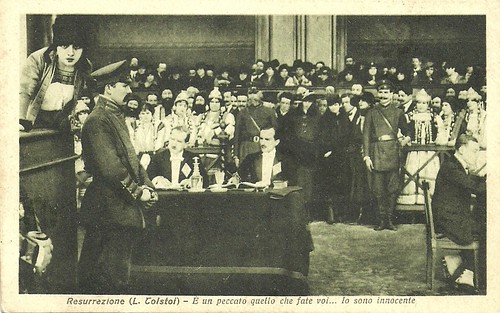
Italian postcard for Resurrezione (Mario Caserini, 1917) with Maria Jacobini. Caption: It is a sin what you're doing... I am innocent.
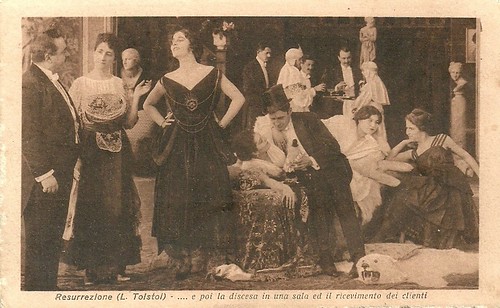
Italian postcard for Resurrezione (Mario Caserini, 1917) with Maria Jacobini. Caption: ... and then descending to a room and the reception of the guests.
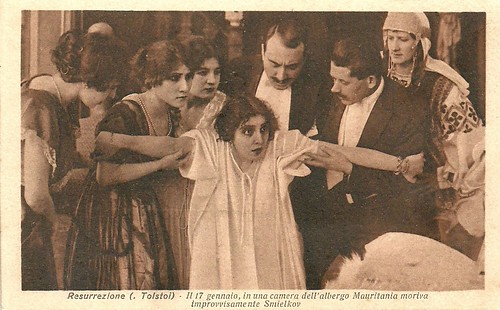
Italian postcard for Resurrezione (Mario Caserini, 1917) with Maria Jacobini. Caption: On 17 January in a room of Hotel Mauritania, Smielkov suddenly died.
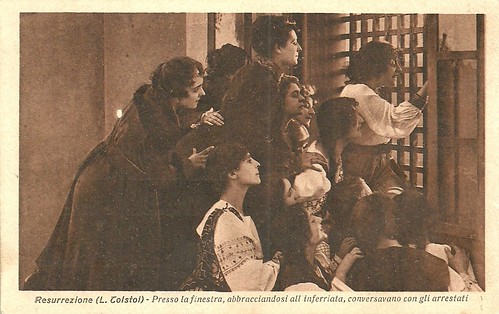
Italian postcard for Resurrezione (Mario Caserini, 1917). Caption: Close to the window, holding the iron grill, they talked to the arrested.
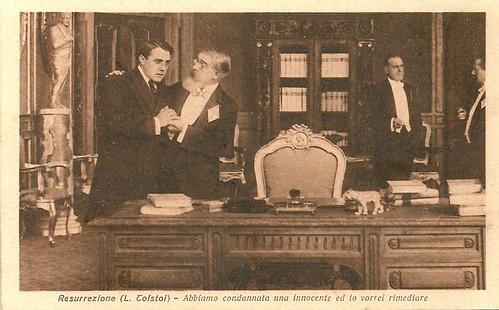
Italian postcard for Resurrezione (Mario Caserini, 1917) with André Habay. Caption: We have sentenced an innocent and I want to repair.
Resurrezione/Resurrection (1917) is based on the novel Voskreseniye, first published in 1899. It was the last novel written by Leo Tolstoy. The novel had already been filmed before by D.W. Griffith in 1909 as Resurrection and in Russia as Katyusha Maslova (Pyotr Chardynin, 1915), the first film role of Natalya Lisenko (or Nathalie Lissenko).
While member of a jury, the rich Prince Dmitri Ivanovich Nekhlyudov (André Habay) recognises the accused Katusa Maslova (Maria Jacobini). She is the girl who was once a maid in his family and whom he seduced, forcing her into prostitution.
She is framed for the murder of a business man and sent to Siberia. Dmitri visits her in prison, hears other stories of other prisoners and realises his gilded life and class justice. Even when loving him back, Maslova refuses to marry him, as she wants to free him from her.
Tolstoy intended the novel as an exposition of the injustice of man-made laws and the hypocrisy of the institutionalised church. The novel also explores the economic philosophy of Georgism, of which Tolstoy had become a very strong advocate towards the end of his life, and explains the theory in detail. It was first published serially in the popular weekly magazine Niva in an effort to raise funds for the resettlement of the Doukhobors.
Resurrezione/Resurrection (Mario Caserini, 1917) premiered in Rome on 26 April 1917. Other film adaptations include the Italian film Resurrection (1944); a Chinese film version entitled 蕩婦心/A Forgotten Woman (1944) starring Bai Guang; a Russian film version directed by Mikhail Shveitser in 1960, with Yevgeny Matveyev. The best-known film version, however, is Samuel Goldwyn's English-language We Live Again (Rouben Mamoulian, 1934) with Fredric March and Anna Sten. Finally, the Italian directors Paolo and Vittorio Taviani released a TV film Resurrezione in 2001.
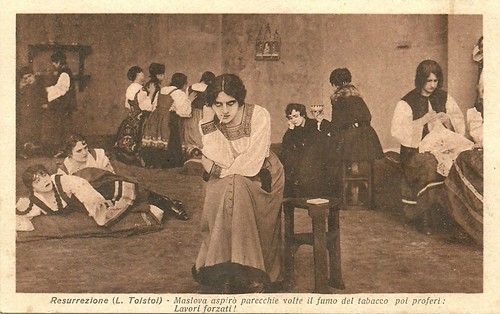
Italian postcard for Resurrezione (Mario Caserini, 1917) with Maria Jacobini. Caption: Maslova inhaled the tobacco's smoke a few times, then uttered: Forced labour!
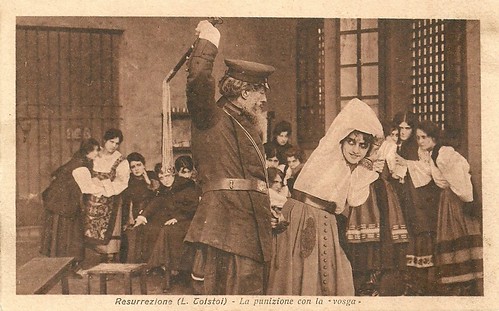
Italian postcard for Resurrezione (Mario Caserini, 1917) with Maria Jacobini. Caption: the punishment with the 'vosga' (like a cat o'nine tails).
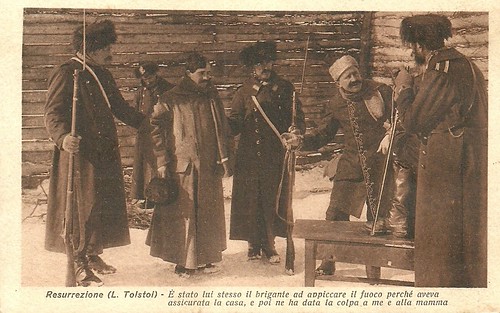
Italian postcard for Resurrezione (Mario Caserini, 1917). Caption: It is this bandit himself who has set the house on fire because he had insured it, and then he blamed my mother and me for it.
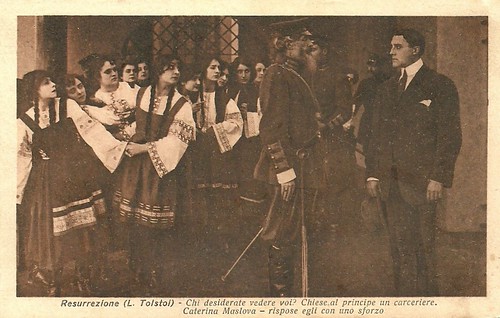
Italian postcard for Resurrezione (Mario Caserini, 1917) with André Habay. Caption: Who do you wish to see? the guardian asked the prince. Katerina Maslova, he answered him with difficulty.
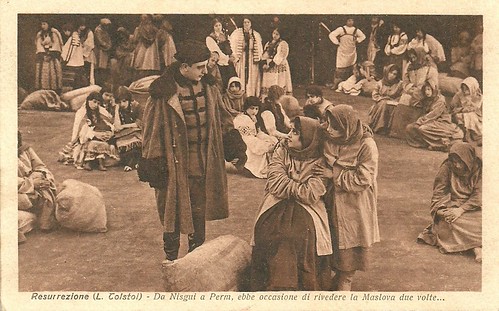
Italian postcard for Resurrezione (Mario Caserini, 1917) with Maria Jacobini and André Habay. Caption: From Nisgui to Perm he had twice occasion to see Maslova again.
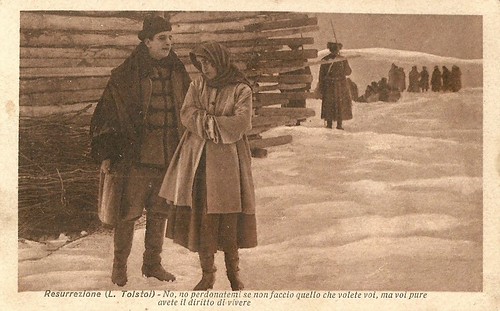
Italian postcard for Resurrezione (Mario Caserini, 1917) with Maria Jacobini and André Habay. Caption: Non, don't forgive me if I don't do what you want, but you have a right to live too.
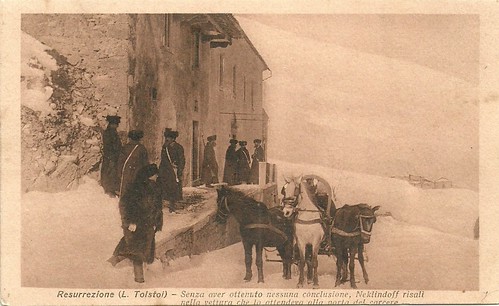
Italian postcard for Resurrezione (Mario Caserini, 1917). Caption: Unable to have obtained anything, Neklindoff got back into the carriage which waited form him at the prison's gate.
Sources: Wikipedia (English and Italian) and IMDb.

Italian postcard for Resurrezione (Mario Caserini, 1917) with Maria Jacobini. Caption: It is a sin what you're doing... I am innocent.

Italian postcard for Resurrezione (Mario Caserini, 1917) with Maria Jacobini. Caption: ... and then descending to a room and the reception of the guests.

Italian postcard for Resurrezione (Mario Caserini, 1917) with Maria Jacobini. Caption: On 17 January in a room of Hotel Mauritania, Smielkov suddenly died.

Italian postcard for Resurrezione (Mario Caserini, 1917). Caption: Close to the window, holding the iron grill, they talked to the arrested.

Italian postcard for Resurrezione (Mario Caserini, 1917) with André Habay. Caption: We have sentenced an innocent and I want to repair.
Forced into prostitution
Resurrezione/Resurrection (1917) is based on the novel Voskreseniye, first published in 1899. It was the last novel written by Leo Tolstoy. The novel had already been filmed before by D.W. Griffith in 1909 as Resurrection and in Russia as Katyusha Maslova (Pyotr Chardynin, 1915), the first film role of Natalya Lisenko (or Nathalie Lissenko).
While member of a jury, the rich Prince Dmitri Ivanovich Nekhlyudov (André Habay) recognises the accused Katusa Maslova (Maria Jacobini). She is the girl who was once a maid in his family and whom he seduced, forcing her into prostitution.
She is framed for the murder of a business man and sent to Siberia. Dmitri visits her in prison, hears other stories of other prisoners and realises his gilded life and class justice. Even when loving him back, Maslova refuses to marry him, as she wants to free him from her.
Tolstoy intended the novel as an exposition of the injustice of man-made laws and the hypocrisy of the institutionalised church. The novel also explores the economic philosophy of Georgism, of which Tolstoy had become a very strong advocate towards the end of his life, and explains the theory in detail. It was first published serially in the popular weekly magazine Niva in an effort to raise funds for the resettlement of the Doukhobors.
Resurrezione/Resurrection (Mario Caserini, 1917) premiered in Rome on 26 April 1917. Other film adaptations include the Italian film Resurrection (1944); a Chinese film version entitled 蕩婦心/A Forgotten Woman (1944) starring Bai Guang; a Russian film version directed by Mikhail Shveitser in 1960, with Yevgeny Matveyev. The best-known film version, however, is Samuel Goldwyn's English-language We Live Again (Rouben Mamoulian, 1934) with Fredric March and Anna Sten. Finally, the Italian directors Paolo and Vittorio Taviani released a TV film Resurrezione in 2001.

Italian postcard for Resurrezione (Mario Caserini, 1917) with Maria Jacobini. Caption: Maslova inhaled the tobacco's smoke a few times, then uttered: Forced labour!

Italian postcard for Resurrezione (Mario Caserini, 1917) with Maria Jacobini. Caption: the punishment with the 'vosga' (like a cat o'nine tails).

Italian postcard for Resurrezione (Mario Caserini, 1917). Caption: It is this bandit himself who has set the house on fire because he had insured it, and then he blamed my mother and me for it.

Italian postcard for Resurrezione (Mario Caserini, 1917) with André Habay. Caption: Who do you wish to see? the guardian asked the prince. Katerina Maslova, he answered him with difficulty.

Italian postcard for Resurrezione (Mario Caserini, 1917) with Maria Jacobini and André Habay. Caption: From Nisgui to Perm he had twice occasion to see Maslova again.

Italian postcard for Resurrezione (Mario Caserini, 1917) with Maria Jacobini and André Habay. Caption: Non, don't forgive me if I don't do what you want, but you have a right to live too.

Italian postcard for Resurrezione (Mario Caserini, 1917). Caption: Unable to have obtained anything, Neklindoff got back into the carriage which waited form him at the prison's gate.
Sources: Wikipedia (English and Italian) and IMDb.
No comments:
Post a Comment